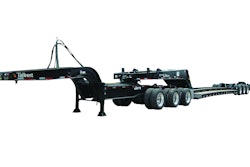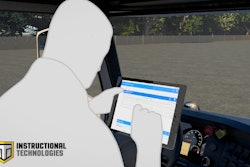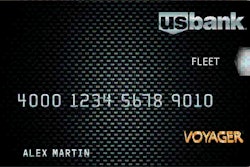BlackBerry devices were once the most popular connectivity tools for business professionals. Many became skilled, and perhaps addicted, to feverishly tapping out emails using the miniature keyboards of their “CrackBerry” devices.
Then, in 2007, Apple came out with the iPhone and others quickly jumped on the bandwagon to develop smartphones with full touchscreens, high-definition cameras and an ecosystem of apps.
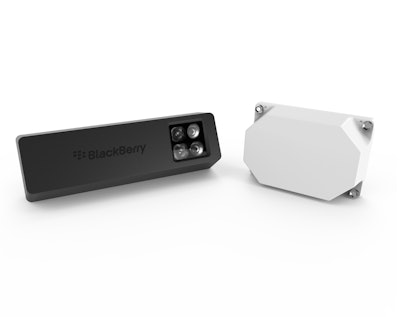 The BlackBerry Radar platform for trailer tracking uses a self-contained unit with internal sensors.
The BlackBerry Radar platform for trailer tracking uses a self-contained unit with internal sensors.Unable to keep up with this new wave of consumer technology, BlackBerry turned to opportunities in the burgeoning market of connected vehicles and transportation.
BlackBerry’s QNX software division soon became the dominant software platform of infotainment systems, communications and autonomous vehicle solutions. The software today powers more than 60 million vehicles on the road.
In the commercial vehicle space, BlackBerry focused on fleet management technology and recently developed a management platform for trailers called BlackBerry Radar.
On Monday, Dec. 18, BlackBerry announced that Radar is now available to more than 2,800 heavy-duty truck dealerships across North America through its agreement with Pana-Pacific.
“We decided to add BlackBerry Radar to our portfolio because we believe the near-real-time information it provides will empower our customers to make better business decisions and improve the overall performance of their transportation operations,” said John Trenberth, chief executive of Pana-Pacific.
“We’re excited to partner with forward-thinking companies, like Pana-Pacific, who realize the value that technology and actionable data can provide to the transportation and logistics industry,” added Philip Poulidis, senior vice presidnet and general manager of Radar for BlackBerry.
The new BlackBerry Radar platform uses a self-contained device to capture location and status information about the equipment and cargo. Its internal sensors capture GPS locations, temperature, humidity, barometric pressure and cargo and door status.
Whereas cargo sensors of competing systems capture binary loaded/unloaded status, BlackBerry Radar uses infrared sensors that capture the percentage of load in a trailer and the door status (open or closed).
The mobile device records location and sensor data in 5-minute increments, and the data record is wirelessly transmitted to the cloud-based system in intervals that preserve battery life and meet the information needs of fleets.
BlackBerry Radar uses high capacity lithium chloride batteries. The batteries are not rechargeable, by design, to eliminate failure points of wired connections to an external power supply from the tractor or from solar panels, Poulidis says.
The batteries last more than three years if fleets configure BlackBerry Radar to transmit data in 15-minute intervals. Most fleets will be satisfied using two-hour transmission intervals, at which rate the batteries will last for eight years, he explains.
With no wiring or external sensors, the product can be installed under 10 minutes, he says, and fleets can expect zero maintenance even in harsh environments of extreme cold, heat, humidity and altitudes.
Soon after announcing BlackBerry Radar, the company entered into a relationship with Fleet Complete, an in-cab fleet management technology supplier. The companies have paired the two systems to give motor carriers visibility of tractor and trailer assets.
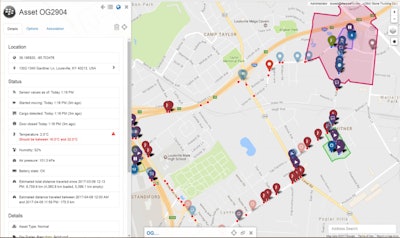 The internal sensors of BlackBerry Radar capture location, temperature, humidity, barometric pressure and more in 5-minute intervals.
The internal sensors of BlackBerry Radar capture location, temperature, humidity, barometric pressure and more in 5-minute intervals.One benefit of using both systems is fleets can give drivers visibility of trailers, chassis or container locations when dispatched to a yard to pick up their equipment. The location of the trailer asset will be made visible to the driver in Fleet Complete’s in-cab display, eliminating time spent searching in a yard, he says.
The partnership also enables new business models, he explains. Last March, Fleet Complete acquired BigRoad and in November announced BigRoad Freight, a load matching platform that is now available within the BigRoad mobile app used by owner-operators and small carrier drivers.
By using the app, drivers can find available loads from freight brokers and provide visibility to shipments and hours-of-service status. As more assets are equipped with Fleet Complete and BlackBerry Radar, the capabilities of BigRoad Freight grow as more assets can be made visible to shippers and freight brokers to offer loads, he says.
The Radar devices will provide BigRoad’s customers with visibility into the available load capacity of their trailers, which will then enable the platform to match drivers with additional shipments along their route.



